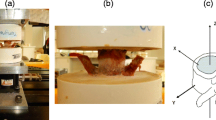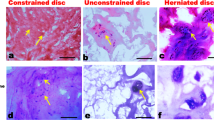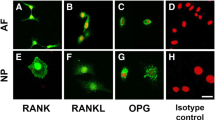Abstract.
During the process of degeneration, the intervertebral disc (IVD) shows a progressive and significant reduction in height due to tissue resorption. Intradiscal clefts and tears are major hallmarks of disc degeneration. Matrix-degrading enzymes such as matrix metalloproteinases (MMPs) are assumed to play a pivotal role in disc tissue degradation and resorption. The objective of this study was therefore to investigate the potential role of MMPs in extracellular matrix degradation leading to disc degeneration. This study was conducted on 30 formalin-fixed and EDTA-decalcified complete cross-sections of lumbar IVDs from cadavers of individuals aged between 0 and 86 years. Tissue sections were used for the immunolocalization of MMPs-1, -2, -3 and -9. The number of labeled cells was assessed by morphometric analyses, and was statistically correlated with the formation of clefts and tears, cellular proliferation, granular matrix changes and mucous degeneration. Furthermore, 30 disc specimens obtained during spinal surgery were used for in situ hybridization of MMP-2 and -3-mRNA. In addition, the enzymatic gelatinolytic activity was determined by in situ zymography in autopsy material. Immunohistochemistry showed the intradiscal expression of all four MMPs, which was confirmed by in situ hybridization, providing clear evidence for the synthesis of the enzymes within nucleus pulposus and annulus fibrosus cells. Gelatinolytic enzymatic activity was verified by in situ zymography. IVDs from infants and young adolescents remained almost completely unlabeled for all MMPs tested, while more MMPs-1 and -3 were seen in disc cells of younger adults than in those of a more advanced age; MMP-2 remained unchanged over the adult age periods, and MMP-9 was expressed in only relatively few cells. This pattern significantly correlated with the occurrence of clefts and tears. This correlation was strongest for MMP-1 (P<0.0001), MMP-2 (P<0.0017) and MMP-3 (P<0.0005) in the nucleus, and MMP-1 (P<0.0001) and MMP-2 (P<0.038) in the annulus. In parallel, the proliferation of disc cells and matrix degeneration (granular changes and mucous degeneration) were related to MMP expression. Likewise, enzymatic activity was seen in association with cleft formation. Our data suggest that major MMPs play an important role in the degradation of the IVD. This is evidenced by the high correlation of MMP expression with the formation of clefts and tears. These findings implicate a leading function for MMPs in IVD degeneration resulting in the loss of normal disc function, eventually leading to low-back pain.
Similar content being viewed by others
Author information
Authors and Affiliations
Additional information
Electronic Publication
Rights and permissions
About this article
Cite this article
Weiler, C., Nerlich, A., Zipperer, J. et al. 2002 SSE Award Competition in Basic Science: Expression of major matrix metalloproteinases is associated with intervertebral disc degradation and resorption. Eur Spine J 11, 308–320 (2002). https://doi.org/10.1007/s00586-002-0472-0
Received:
Accepted:
Published:
Issue Date:
DOI: https://doi.org/10.1007/s00586-002-0472-0




